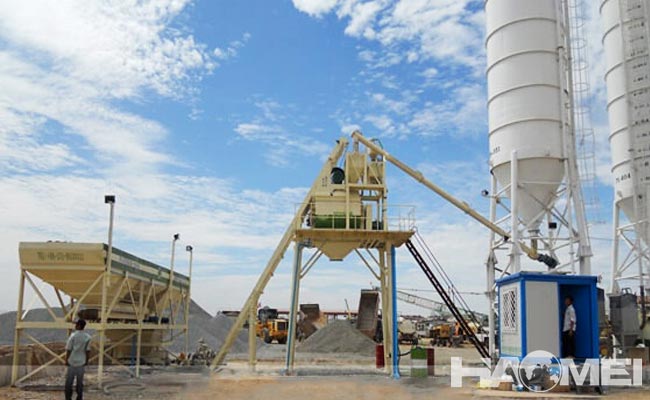Categories
- Case & News (50)
- Blog (565)
A hopper feeding concrete batching plant is a concrete production equipment that vertically lifts raw materials (such as sand, stone, cement, etc.) to the main mixer through a hopper. Its core feature is the “hopper + track/winch” feeding method, which is suitable for small and medium-sized concrete production scenarios.

Structural composition of hopper feeding concrete batching plant:
1. Storage system
– Aggregate silo: Aggregates such as sand and stone are stored in separate silos, usually steel structures, with gates at the bottom to control the discharge of materials.
– Cement silo: Stores powder (cement, fly ash, etc.), equipped with a screw conveyor to feed the weighing system.
2. Weighing system
– Aggregate weighing hopper: Accurately measures the weight of sand and stone through sensors.
– Powder weighing tank: Measure cement and other powders.
– Water and admixture weighing: Use flow meters or weighing containers to control the ratio.
3. Lifting system
– Hopper: Metal container, loaded with weighed aggregates.
– Track and winch: The hopper is pulled along the inclined track by the wire rope to the mixer feed port.
4. Mixing host
– Most of them are forced twin-shaft concrete mixers to ensure efficient and uniform mixing.
5. Control system
– PLC automatically controls the proportioning, lifting and mixing processes, and supports manual/automatic switching.
Working principle of hopper feeding concrete batching plant:
1. Raw material storage: Aggregates and cement are stored in corresponding silos respectively.
2. Accurate weighing: Each material is weighed according to the preset ratio.
3. Bucket lifting: Aggregates enter the hopper, and the winch is pulled to the top of the mixer and poured.
4. Mixing and stirring: Cement, water and admixtures are added simultaneously, and mixed for 3-5 minutes to form concrete.
5. Unloading and transportation: The finished concrete is loaded into a mixer truck or a trolley through the unloading door.
Core advantages of hopper feeding concrete batching plant:
1. Compact and efficient
– The vertical lifting design saves horizontal space and is suitable for small areas (such as towns and mountainous areas).
2. Low cost
– Simple structure, investment and maintenance costs are lower than belt conveyor type concrete batching plants.
3. Flexible adaptation
– Modular design facilitates disassembly and relocation, and adapts to temporary project needs.
4. Strong stability
– Track lifting reduces aggregate spillage and is environmentally friendly.
Applicable scenarios of hopper feeding concrete batching plants:
– Small and medium-sized projects: rural housing construction, road hardening, small water conservancy and other low-intensity demand projects.
– Short-cycle construction: temporary projects with short construction periods and rapid transfer (such as emergency repair projects).
– Environmental protection strictly controlled areas: closed hoppers reduce dust leakage and are suitable for areas with high environmental protection requirements.
– Limited funding projects: replace large concrete batching plants when the budget is low to reduce initial investment.
Comparison and limitations
– Comparison with belt-type concrete batching plants: hopper-type loading speed is slow (output is about 25-75m³ per hour), suitable for small batch production; belt-type is suitable for continuous operation (output is more than 100m³/h).
– Limitations: Aggregate size must be ≤80mm, oversized aggregates are prone to get stuck in the bucket; frequent lifting may increase energy consumption.
Hopper feeding concrete batching plants are ideal for small and medium-sized projects and special sites due to their economy and flexibility, but efficiency needs to be weighed in large-scale continuous production.